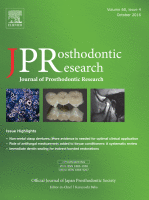60 巻, 4 号
Journal of Prosthodontic Research
選択された号の論文の17件中1~17を表示しています
- |<
- <
- 1
- >
- >|
Editorial
-
2016 年 60 巻 4 号 p. 227-228
発行日: 2016/10/25
公開日: 2016/12/02
PDF形式でダウンロード (377K)
Letter to the Editor
-
2016 年 60 巻 4 号 p. 229-230
発行日: 2016/10/25
公開日: 2016/12/02
PDF形式でダウンロード (292K)
Reviews
-
2016 年 60 巻 4 号 p. 231-239
発行日: 2016/10/25
公開日: 2016/12/02
PDF形式でダウンロード (807K) -
2016 年 60 巻 4 号 p. 240-249
発行日: 2016/10/25
公開日: 2016/12/02
PDF形式でダウンロード (497K)
Original Articles
-
2016 年 60 巻 4 号 p. 250-257
発行日: 2016/10/25
公開日: 2016/12/02
PDF形式でダウンロード (475K) -
2016 年 60 巻 4 号 p. 258-264
発行日: 2016/10/25
公開日: 2016/12/02
PDF形式でダウンロード (656K) -
2016 年 60 巻 4 号 p. 265-273
発行日: 2016/10/25
公開日: 2016/12/02
PDF形式でダウンロード (2689K) -
2016 年 60 巻 4 号 p. 274-281
発行日: 2016/10/25
公開日: 2016/12/02
PDF形式でダウンロード (3292K) -
2016 年 60 巻 4 号 p. 282-288
発行日: 2016/10/25
公開日: 2016/12/02
PDF形式でダウンロード (1251K) -
2016 年 60 巻 4 号 p. 289-293
発行日: 2016/10/25
公開日: 2016/12/02
PDF形式でダウンロード (607K) -
2016 年 60 巻 4 号 p. 294-300
発行日: 2016/10/25
公開日: 2016/12/02
PDF形式でダウンロード (1281K) -
2016 年 60 巻 4 号 p. 301-307
発行日: 2016/10/25
公開日: 2016/12/02
PDF形式でダウンロード (874K) -
2016 年 60 巻 4 号 p. 308-314
発行日: 2016/10/25
公開日: 2016/12/02
PDF形式でダウンロード (947K) -
2016 年 60 巻 4 号 p. 315-320
発行日: 2016/10/25
公開日: 2016/12/02
PDF形式でダウンロード (571K)
Technical Procedure
-
2016 年 60 巻 4 号 p. 321-331
発行日: 2016/10/25
公開日: 2016/12/02
PDF形式でダウンロード (3810K)
Case Report
-
2016 年 60 巻 4 号 p. 332-336
発行日: 2016/10/25
公開日: 2016/12/02
PDF形式でダウンロード (1160K) -
2016 年 60 巻 4 号 p. 337-343
発行日: 2016/10/25
公開日: 2016/12/02
PDF形式でダウンロード (2101K)
- |<
- <
- 1
- >
- >|
